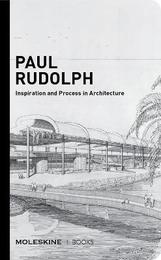
|
Paul Rudolph: Inspiration and Process in Architecture
Hardback
Main Details
Description
Paul Rudolph (1918-1997) authored some of Modernism's most powerful designs and served as an influential educator while chair of Yale's School of Architecture. His early residential work in Sarasota, Florida, garnered international attention, and his later exploration of Brutalist materials and forms, most famously embodied in his Yale Art & Architecture Building (1963), earned Rudolph both notoriety and acclaim. Many of the dynamic drawings included in this collection-selected from the architect's archive housed in the Library of Congress-illustrate his highly emotive hand and deft drafting skill. They include his designs for Tuskegee University Chapel, Interama, Lower Manhattan Expressway, his analysis of Mies van der Rohe's Barcelona Pavilion, and his own inventive penthouse on Beekman Place in New York City. A lively Rudolph interview, conducted in 1986, and a newly commissioned introductory essay provide context for the drawings.
Author Biography
John Morris Dixon, an architecture critic and board member of Docomomo New York / Tri-State, was editor-in-chief of Progressive Architecture from 1972 to 1996.
Reviews"Those needing a fix for Rudolph's drawings should consider...this new sketchbook-sized book with dozens of the architect's drawings, ranging from his Florida projects in the 1950s to his Asian skyscrapers in the 1980s....[The drawings in the book] come after two pieces of text that clearly put Rudolph's drawings into context: an introduction by John Morris Dixon and an excerpt from a 1980s interview between Rudolph and Robert Bruegmann as part of the Chicago Architects Oral History Project." - A Daily Dose of Architecture Books "Get to know one of 20th-century architecture's most idiosyncratic practitioners, Paul Rudolph, through a man who knew him well: John Morris Dixon, FAIA, a contributor to ARCHITECT and the editor-in-chief of Progressive Architecture from 1972 to 1996. Dixon's Paul Rudolph: Inspiration and Process in Architecture includes a new essay by the author, a 1986 interview with Rudolph, and dozens of sketches and other matter from the archives of the Library of Congress. Not surprisingly, given that it was published by Moleskine Books, the 144-page volume looks just like one of the iconic sketchbooks-rounded corners, ribbon place marker, and all." - ARCHITECT Magazine "You have to understand that I'm not too much interested in what other people are doing," said Paul Rudolph in 1986. The sentiment succinctly sums up the self-confidence revealed by the heroic modern architect's drawings and sketches, captured here in a compact Moleskine notebook. Although his built work could be controversial, the impressive designs, such as the unrealized Lower Manhattan Expressway, along with other evocative proposals, result in a handsome compendium of the architect's contributions." - Architectural Record
|